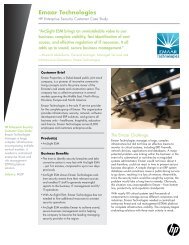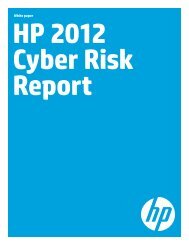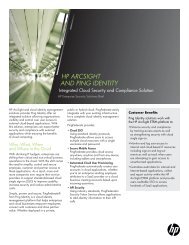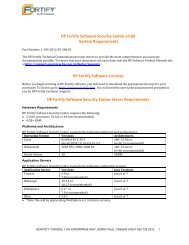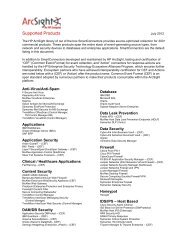Big security for big data - Business whitepaper ... - Hewlett Packard
Big security for big data - Business whitepaper ... - Hewlett Packard
Big security for big data - Business whitepaper ... - Hewlett Packard
Create successful ePaper yourself
Turn your PDF publications into a flip-book with our unique Google optimized e-Paper software.
<strong>Business</strong> white paper<br />
<strong>Big</strong> <strong>security</strong><br />
<strong>for</strong> <strong>big</strong> <strong>data</strong>
Table of contents<br />
3 <strong>Big</strong> <strong>security</strong> <strong>for</strong> <strong>big</strong> <strong>data</strong><br />
3 Data explosion<br />
3 Data collection<br />
5 Data integration<br />
5 Data analytics<br />
5 In real time versus the past<br />
6 Born <strong>for</strong> faster speed<br />
6 Real-time threat evaluation<br />
7 Pattern matching<br />
7 Statistical correlation<br />
7 Monitor and respond<br />
8 Conclusion<br />
8 About HP Enterprise Security<br />
8 Protect your business
Customers are generating lots of <strong>data</strong><br />
Figure 1. Data is generated at a much faster pace<br />
kaggle<br />
Pandora<br />
Music<br />
SolidFire<br />
Scribd. SmugMug<br />
iHan dy<br />
Amazon<br />
Finance<br />
SuperCam<br />
sales<strong>for</strong>ce.com<br />
AppFog<br />
Joyent Plex Systems<br />
Travel<br />
Snap fish<br />
Urban<br />
DC C<br />
Google<br />
Xactly Facebook Parse<br />
Product SAP<br />
eBay<br />
Drag on Diction<br />
PingMe<br />
GoGrid Linked In<br />
Reference<br />
Configurator<br />
CCC<br />
CRM<br />
Hosting.com<br />
HP<br />
UPS Mobile<br />
Bromium Atlassian<br />
Tata Communications<br />
Bills of Material<br />
buzzd<br />
Lifestyle<br />
Engineering<br />
Ariba NetReach<br />
Amazon Web Services<br />
SCM<br />
Inventory<br />
Quickb ooks<br />
Splu nk Sport<br />
NetDocumen ts<br />
Quality Control<br />
Zoho<br />
Scan ner Pro LimeLight<br />
Burroughs<br />
EMC<br />
Alterian<br />
box.net<br />
ScaleXtreme<br />
HC M<br />
Fo ursquare<br />
Datapipe<br />
Qvidian<br />
Taleo<br />
Educatio n<br />
Pinterest<br />
Hitachi<br />
Cost Management<br />
Hyland<br />
IBM<br />
MRM<br />
Open Text<br />
Unisys Manufacturing Projects Order Entry<br />
Workscap e Sage NetSuite<br />
Mainframe<br />
Client/server<br />
The Internet<br />
Mobile, social,<br />
<strong>big</strong> <strong>data</strong> & the cloud<br />
98,000<br />
tweets<br />
23,148 apps<br />
downloaded<br />
400,710 ad<br />
requests<br />
Every<br />
60 seconds<br />
Cash Management<br />
CyberShift<br />
PaperHost<br />
DocuSign<br />
CloudSigma<br />
Bull<br />
NEC<br />
ERP<br />
Yandex<br />
HC M<br />
Game s Baidu<br />
Hootsuite<br />
Xerox<br />
Yahoo!<br />
Fijitsu<br />
Time an d Expense<br />
Microsoft<br />
Serif<br />
nebula<br />
YouTube<br />
Costing<br />
Accounts Fixed Assets<br />
HP ePrint<br />
Atlassian<br />
OpSource<br />
SLI Systems<br />
Workbrain Zynga<br />
Navigation<br />
Receivab le<br />
Avid<br />
Billing<br />
Elemica<br />
Workday<br />
Mixi<br />
iSched ule<br />
cloudability<br />
Payroll<br />
ADP VirtualE dge<br />
Yandex<br />
Activity<br />
Photo & Video<br />
PLM<br />
Corel<br />
SCM<br />
Khan Acad emy Twitter<br />
Heroku<br />
Training<br />
Management<br />
Adobe<br />
CyberShift<br />
Zillab yte<br />
Yammer<br />
Sales tracking &<br />
Renren<br />
Marketing<br />
Time & Rostering<br />
Yahoo<br />
SuccessFactors Entertainment Viber<br />
Kinaxis<br />
Attendan ce<br />
Microsoft<br />
SugarCRM<br />
Ne ws Atlassian<br />
Answ ers.com<br />
Database Service<br />
Saba<br />
Commissions<br />
Social Ne tworking<br />
PPM<br />
BrainPOP RightScale<br />
Sonar6<br />
Claim ProcessingData Warehousing<br />
Quad rem<br />
CYworld<br />
Kenexa<br />
Sonar6<br />
MobileFrame.com<br />
Saba<br />
<strong>Business</strong> Jive Software<br />
myHomework<br />
Softscap e<br />
NetSuite<br />
Tumblr.<br />
Qzone<br />
Intacct<br />
Fring<br />
Toggl<br />
Amazon dotClo ud<br />
Cornerstone onDemand<br />
Exact Online<br />
Cookie Doodle<br />
Xing<br />
Mozy<br />
FinancialForce.com<br />
New Relic<br />
Softscap e<br />
MailChimp<br />
PingMe<br />
Util itie s Zynga<br />
Ah! Fasion Girl<br />
IntraLinks Volu sion<br />
Associated conten t<br />
Beyo ndCore<br />
SmugMug<br />
MobilieIron<br />
Fed Ex Mobile Productivity<br />
Rackspace Flickr<br />
Twitter<br />
Paint.NET<br />
TripIt<br />
2000 lyrics played<br />
on Tunewiki<br />
1500 pings<br />
sent on PingMe<br />
34,597 people<br />
using Zinio<br />
208,333 minutes of<br />
Angry Birds played<br />
<strong>Big</strong> <strong>security</strong> <strong>for</strong> <strong>big</strong> <strong>data</strong><br />
We are children of the in<strong>for</strong>mation generation. No longer tied<br />
to large mainframe computers, we now access in<strong>for</strong>mation via<br />
applications, mobile devices, and laptops to make decisions based<br />
on real-time <strong>data</strong>. It is because in<strong>for</strong>mation is so pervasive that<br />
businesses want to capture this <strong>data</strong> and analyze it <strong>for</strong> intelligence.<br />
Data explosion<br />
The multitude of devices, users, and generated traffic all combine<br />
to create a proliferation of <strong>data</strong> that is being created with incredible<br />
volume, velocity, and variety. As a result, organizations need a<br />
way to protect, utilize, and gain real-time insight from “<strong>big</strong> <strong>data</strong>.”<br />
This intelligence is not only valuable to businesses and consumers,<br />
but also to hackers. Robust in<strong>for</strong>mation marketplaces have arisen<br />
<strong>for</strong> hackers to sell credit card in<strong>for</strong>mation, account usernames,<br />
passwords, national secrets (WikiLeaks), as well as intellectual<br />
property. How does anyone keep secrets anymore How does<br />
anyone keep secrets protected from hackers<br />
In the past when the network infrastructure was straight<strong>for</strong>ward<br />
and perimeters used to exist, controlling access to <strong>data</strong> was much<br />
simpler. If your secrets rested within the company network, all<br />
you had to do to keep the <strong>data</strong> safe was to make sure you had a<br />
strong firewall in place. However, as <strong>data</strong> became available through<br />
the Internet, mobile devices, and the cloud having a firewall was<br />
not enough. Companies tried to solve each <strong>security</strong> problem in a<br />
piecemeal manner, tacking on more <strong>security</strong> devices like patching a<br />
hole in the wall. But, because these products did not interoperate,<br />
you could not coordinate a defense against hackers.<br />
In order to meet the current <strong>security</strong> problems faced by<br />
organizations, a new paradigm shift needs to occur. <strong>Business</strong>es need<br />
the ability to secure <strong>data</strong>, collect it, and aggregate into an intelligent<br />
<strong>for</strong>mat, so that real-time alerting and reporting can take place. The<br />
first step is to establish complete visibility so that your <strong>data</strong> and who<br />
accesses the <strong>data</strong> can be monitored. Next, you need to understand<br />
the context, so that you can focus on the valued assets, which are<br />
critical to your business. Finally, utilize the intelligence gathered so<br />
that you can harden your attack surface and stop attacks be<strong>for</strong>e the<br />
<strong>data</strong> is exfiltrated. So, how do we get started<br />
Data collection<br />
Your first job is to aggregate all the in<strong>for</strong>mation from every<br />
device into one place. This means collecting in<strong>for</strong>mation from<br />
cloud, virtual, and real appliances: network devices, applications,<br />
servers, <strong>data</strong>bases, desktops, and <strong>security</strong> devices. With<br />
Software-as-a-Service (SaaS) applications deployed in the cloud,<br />
it is important to collect logs from those applications as well since<br />
<strong>data</strong> stored in the cloud can contain in<strong>for</strong>mation spanning from<br />
human resource management to customer in<strong>for</strong>mation. Collecting<br />
this in<strong>for</strong>mation gives you visibility into who is accessing your<br />
company’s in<strong>for</strong>mation, what in<strong>for</strong>mation they are accessing, and<br />
when this access is occurring. The goal is to capture usage patterns<br />
and look <strong>for</strong> signs of malicious behavior.<br />
Typically, <strong>data</strong> theft is done in five stages 1 . First, hackers “research”<br />
their target in order to find a way to enter the network. After<br />
“infiltrating” the network, they may install an agent to lie dormant<br />
and gather in<strong>for</strong>mation until they “discover” where the payload is<br />
hosted, and how to “acquire” it. Once the target is captured, the<br />
next step is to “exfiltrate” the in<strong>for</strong>mation out of the network. Most<br />
advanced attacks progress through these five stages, and having this<br />
understanding helps you look <strong>for</strong> clues on whether an attack is taking<br />
place in your environment, and how to stop the attacker from reaching<br />
their target. The key to determining what logs to collect are to focus<br />
on records where an actor is accessing in<strong>for</strong>mation or systems.<br />
3
Four steps to <strong>security</strong> intelligence<br />
Benefits<br />
1<br />
2<br />
3<br />
4<br />
Data collection from cloud,<br />
virtual, and real devices <strong>for</strong><br />
complete visibility into <strong>data</strong><br />
and its accessibility.<br />
Data integration through<br />
automation and rule-based<br />
processing. HP ArcSight<br />
normalizes and categorizes log<br />
<strong>data</strong> into over 400 meta fields.<br />
Data analytics which<br />
involves combining logs<br />
from multiple sources and<br />
correlating events together<br />
to create real-time alerts.<br />
HP ArcSight Correlation<br />
Optimized Retention and<br />
Retrieval (CORR) Engine<br />
serves as a foundation <strong>for</strong><br />
threat detection,<br />
<strong>security</strong> analysis, and<br />
log <strong>data</strong> management.<br />
The CORR-Engine helps <strong>security</strong><br />
analysts to:<br />
• Detect more incidents<br />
• Address more <strong>data</strong><br />
• Operate more efficiently<br />
• Evaluate threats in real time<br />
• Find threats faster<br />
• Collect relevant in<strong>for</strong>mation<br />
about user roles, critical assets<br />
and <strong>data</strong> in real time and uses<br />
it to reduce false-positives<br />
Results<br />
• Security event monitoring is<br />
simple, intelligent, efficient,<br />
and manageable<br />
• HP ArcSight Security Event<br />
In<strong>for</strong>mation Management (SIEM)<br />
processes events faster making<br />
<strong>security</strong> in<strong>for</strong>mation available<br />
in real time<br />
4
Analysis: Normalize / Categorize<br />
Figure 2. Analysis: Normalize/Categorize<br />
Without normalization<br />
Jun 17 2009 12:16:03: %PIX-6-106015: Deny TCP (no connection) from 10.50.215.102/15605 to 204.110.227.16/443 flags<br />
FIN ACK on interface outside<br />
Jun 17 2009 14:53:16 drop gw.foobar.com >eth0 product VPN-1 & Firewall-1 srcxxx.xxx.146.12 s_port 2523 dst<br />
xxx.xxx.10.2 service ms-sql-m proto udp rule 49<br />
With normalization<br />
Time (Event Time)<br />
name<br />
Device<br />
Vendor<br />
Device Product<br />
Category<br />
Behavior<br />
Category<br />
Device Group<br />
Category<br />
Outcome<br />
Category<br />
Significance<br />
6/17/2009 12:16:03 Deny Cisco PIX /Access /Firewall /Failure<br />
6/17/2009 14:53:16 Drop Checkpoint Firewall-1/VPN-1 /Access/Start /Firewall /Failure<br />
/In<strong>for</strong>mational/<br />
Warning<br />
/In<strong>for</strong>mational/<br />
Warning<br />
Benefit: Making sense out of the raw <strong>data</strong><br />
Data integration<br />
Once the machine <strong>data</strong> is collected, the <strong>data</strong> needs to be parsed<br />
to derive intelligence from cryptic log messages. Automation and<br />
rule-based processing is needed because having a person review<br />
logs manually would make the problem of finding an attacker quite<br />
difficult since the <strong>security</strong> analyst would need to manually separate<br />
attacks from logs of normal behavior. The solution is to normalize<br />
machine logs so that queries can pull context-aware in<strong>for</strong>mation<br />
from log <strong>data</strong>. For example, HP ArcSight connectors normalize and<br />
categorize log <strong>data</strong> into over 400 meta fields. Logs that have been<br />
normalized become more useful because you no longer need an<br />
expert on a particular device to interpret the log. By enriching logs<br />
with meta<strong>data</strong>, you can turn strings of text into in<strong>for</strong>mation that can<br />
be indexed and searched.<br />
Data analytics<br />
Normalized logs are indexed and categorized to make it easy <strong>for</strong><br />
a correlation engine to process and identify patterns based on<br />
heuristics and <strong>security</strong> rules. It is here where the art of combining logs<br />
from multiple sources and correlating events together help to create<br />
real-time alerts. This preprocessing also speeds up correlation and<br />
makes vendor-agnostic event logs, which give analysts the ability to<br />
build reports and filters with simple English queries.<br />
In real time versus the past<br />
Catching a hacker and being able to stop them as the attack is taking<br />
place is more useful to a company than being able to use <strong>for</strong>ensics to<br />
piece together an attack that already took place. However, in order to<br />
have that as part of your arsenal, we have to resolve four problems:<br />
• How do you insert <strong>data</strong> faster into your <strong>data</strong> store<br />
• How do you store all this <strong>data</strong><br />
• How do you quickly process events<br />
• How do you return results faster<br />
Figure 3. Per<strong>for</strong>mance improvements of ESM with CORR-Engine over ESM with Oracle<br />
Per<strong>for</strong>mance gains over 5.2<br />
20<br />
15<br />
10<br />
5<br />
0<br />
20<br />
Oracle<br />
CORR<br />
1 1 1<br />
3<br />
15<br />
Storage EPS Query<br />
Detect more Detect incidents more incidents<br />
Up to 3x the current per<strong>for</strong>mance using the same hardware<br />
Up to 3x the current per<strong>for</strong>mance (events per second [EPS]) using<br />
Faster Query 15x<br />
the same hardware<br />
Address more Faster <strong>data</strong>query 15x 2<br />
Up to 20x the current capacity <strong>for</strong> correlated events<br />
using the same Address disk space more <strong>data</strong><br />
Up to 20x the current capacity <strong>for</strong><br />
Operate more<br />
correlated<br />
efficiently<br />
events<br />
Frees up <strong>security</strong> analyst cycles <strong>for</strong> proactive monitoring<br />
No DBA needed using the same disk space 2<br />
Operate more efficiently<br />
Frees up <strong>security</strong> analyst cycles <strong>for</strong> proactive monitoring<br />
No DBA needed<br />
5
At HP ArcSight, we have been evolving our solution <strong>for</strong> over 12 years.<br />
When we created our first SIEM product, Oracle’s <strong>data</strong>base was<br />
the best <strong>data</strong> store. However, as the problem space of our SIEM<br />
customers evolved over the years and <strong>big</strong> <strong>data</strong> became prevalent;<br />
it was important to redesign our solution to handle the new<br />
challenges. The <strong>data</strong> store now needs to capture more events,<br />
compress and archive more <strong>data</strong>, and execute searches much faster.<br />
Born <strong>for</strong> faster speed<br />
When we originally introduced this technology into our logger<br />
solution, customers could see the benefits. HP ArcSight’s<br />
CORR-Engine (correlation optimized retention and retrieval) is<br />
uniquely architected to enable a single instance to capture raw<br />
logs at rates of above 100,000 events per second, compress, and<br />
store up to 42 TB of log <strong>data</strong> per instance and execute searches<br />
at millions of events per second. 2 By creating our own <strong>data</strong> store<br />
that utilized both column and row-store technology, we were able<br />
to marry the significant per<strong>for</strong>mance benefits with the flexibility<br />
of free-<strong>for</strong>m unstructured searches, all while providing a very<br />
intuitive, easy-to-operate user interface.<br />
The CORR-Engine serves as a foundation that provides the speed<br />
needed <strong>for</strong> today’s threat detection, <strong>security</strong> analysis, and log <strong>data</strong><br />
management. By processing more events, it can soon identify the<br />
meaning of any event by placing it within context of what, where,<br />
when, and why that event occurred and its impact on the organization.<br />
Our correlation delivers accurate and automated prioritization<br />
of <strong>security</strong> risks and compliance violations in a business relevant<br />
context. Real-time alerts show administrators the most critical<br />
<strong>security</strong> events occurring in the environment, along with the<br />
context necessary to further analyze and mitigate a breach. Using<br />
CORR-Engine, administrators and analysts are able to:<br />
Detect more incidents<br />
• The new architecture allows event correlation rates of up to 3x the<br />
current per<strong>for</strong>mance using the same hardware.<br />
This new capability allows users to search <strong>for</strong> any string or<br />
“keyword” located in the <strong>data</strong>base, regardless of the event type or<br />
source. The HP ArcSight CORR-Engine indexes both raw (unstructured)<br />
and normalized (structured) event <strong>data</strong> to provide rapid search<br />
capabilities. With our combined flat-file and RDBMS technology,<br />
HP ArcSight can return search results in excess of millions events per<br />
second <strong>for</strong> both structured and unstructured <strong>data</strong>.<br />
As a result of using this new <strong>data</strong> store, <strong>security</strong> administrators<br />
could focus on finding malicious activities, not on tuning or<br />
managing the <strong>data</strong>base. Also, central to our ability to process more<br />
events in real time, the new CORR-Engine permitted additional<br />
parallel processing capabilities, up to 80 CPU cores, <strong>big</strong> enough<br />
<strong>for</strong> the <strong>big</strong>gest organizations on the planet. By adding parallel<br />
processing power, HP ArcSight can handle more events, faster in<br />
an easy-to-use interface.<br />
Real-time threat evaluation<br />
HP ArcSight also makes use of actor in<strong>for</strong>mation as a variable in<br />
its threat <strong>for</strong>mula that collects in<strong>for</strong>mation regarding identity<br />
management user roles, critical assets, vulnerability <strong>data</strong>, and<br />
“watch lists” in real time and uses this in<strong>for</strong>mation to reduce<br />
false-positives and monitor critical infrastructure in memory. For<br />
example, if a Microsoft ® SQL Server injection attack is targeting an<br />
Oracle <strong>data</strong>base, HP ArcSight immediately lowers the severity of the<br />
attack, knowing that Oracle is not susceptible to MS SQL attacks.<br />
However, if a privileged user is accessing a critical piece of infrastructure<br />
after regular working hours and inserting a USB thumb drive into their<br />
system, this may generate a number of low severity events. Pieced<br />
together, HP ArcSight would immediately raise the severity of this<br />
activity based on the understanding of the user’s privileges and the<br />
assets criticality. This would start the alert process and start monitoring<br />
activity and workflow processes <strong>for</strong> a potential <strong>security</strong> breach.<br />
Figure 4. Correlation is the key to making sense of 1s and 0s<br />
Address more <strong>data</strong><br />
• The new architecture enables storage capacity of up to 20x the<br />
current capacity <strong>for</strong> correlated events using the same disk space. 2<br />
Operate more efficiently<br />
• The use of a common <strong>data</strong> store allows both the real-time<br />
correlation application and the log management application to use<br />
the same set of <strong>data</strong>, providing a seamless workflow that includes<br />
detection, alerting, and <strong>for</strong>ensic analysis and reporting.<br />
Find threats faster<br />
• The graph above shows the multiples of improvement when we<br />
switched from RDBMS to our own-patented <strong>data</strong> store utilizing our<br />
new CORR-Engine.<br />
History<br />
Privileged user<br />
Role<br />
Anomaly<br />
Asset<br />
Action<br />
Transactions<br />
Session<br />
Location<br />
IP address<br />
6
Pattern matching<br />
HP ArcSight has an expansion pack: Threat Detector which allows<br />
customers to mine through archived <strong>data</strong> looking <strong>for</strong> relationships<br />
between events that would have been missed by real-time correlation.<br />
As an example, a low-and-slow attack takes place when an attacker<br />
purposely lowers the threshold on their attack to avoid detection.<br />
Such an evasive technique might be when the attacker is using a<br />
dictionary attack to guess a user’s password. They would not try<br />
to brute-<strong>for</strong>ce the authentication system all at once, as the system<br />
would lock out the user’s account after a series of unsuccessful login<br />
attempts. So the attacker uses a scripted stealth method of only<br />
attempting to login twice while trying to guess the password, then<br />
sleeps <strong>for</strong> five minutes and continues to invoke two attempts every<br />
five minutes. This means there would be 576 unsuccessful login<br />
attempts daily, but since most correlation rules look <strong>for</strong> brute-<strong>for</strong>ce<br />
methods, only a routine that would mine through historical <strong>data</strong><br />
would be able to match this pattern. Threat Detector would detect<br />
this attack and then allow customers to introduce new rules that<br />
would block the attacker going <strong>for</strong>ward.<br />
Statistical correlation<br />
HP ArcSight’s multidimensional correlation engine combines real time,<br />
in memory event log <strong>data</strong> with asset awareness, asset vulnerability, and<br />
identity correlation to assist operating teams with immediate detection<br />
of threats. The powerful correlation engine allows you to maintain a<br />
state of situational awareness by processing millions of log events<br />
in real time. We help to prioritize critical events so that your <strong>security</strong><br />
administrator can review only those events that need specialized<br />
attention. With built-in network asset and user models, HP ArcSight is<br />
uniquely able to understand who is on the network, what <strong>data</strong> they are<br />
seeing, and which actions they are taking with that <strong>data</strong>.<br />
HP ArcSight Enterprise Security Manager (ESM) uses a heuristic<br />
analytics model to keep a baseline of activity from events<br />
received by ESM and monitors any increases in attack, target,<br />
protocol, or user activity using a percentage threshold. The<br />
statistics that are calculated are used by ESM to determine spikes<br />
in the baseline average as well as other deterministic activity such<br />
as anomalous behavior, session reconciliation, effectiveness of<br />
IDS and firewalls as well as monitoring DHCP lease activity. This<br />
statistical baseline is also used <strong>for</strong> determining anomalous user or<br />
application-usage behavior.<br />
Figure 5. Smart correlation<br />
Collect Detect Respond<br />
What<br />
(Logs)<br />
Who<br />
(User roles)<br />
Better<br />
visibility;<br />
superior threat<br />
detection<br />
Where<br />
(Flows)<br />
Monitor and respond<br />
HP ArcSight proactively alerts and notifies you when malicious activity<br />
has occurred in your environment. However, because of the ability<br />
to process events quickly, we can alert your analysts in real time. For<br />
example, if we detect a distributed denial of services (DDoS) attack,<br />
we can send an email to you and your team, and notify you via your<br />
mobile device. A priority 1 escalation alerts your team so that a<br />
response can be mobilized against a prioritized <strong>security</strong> event. For<br />
example, if the Tier 1 team doesn’t acknowledge a notification within<br />
a certain timeframe, HP ArcSight can automatically escalate this to<br />
your Tier 2 team, tying into your existing response processes and<br />
procedures.<br />
Once you’ve received a notification, you can start to analyze and<br />
investigate your environment using our easy-to-use <strong>data</strong> driven<br />
capabilities. Our dashboards help you visualize where your <strong>data</strong> is<br />
located and provide specialized views from business oriented to<br />
geographical oriented to systems oriented. From the dashboard,<br />
we can drill into the supporting events, drill into any level of detail,<br />
and customize the view and presentation of that <strong>data</strong>. And with<br />
our strong visualization capabilities, you can easily understand the<br />
significance of the <strong>data</strong>.<br />
IT must be able to respond quickly, efficiently, and accurately to help<br />
minimize damage to the enterprise. HP ArcSight Threat Detector<br />
follows a simple three-step methodology:<br />
• Discover the systems on your network<br />
• Analyze what actions we should take and which offer the best results<br />
• Provide guidance on what to do<br />
Intelligent threat and risk detection<br />
−−Intelligent Sophisticated threat correlation and risk detection<br />
-<br />
technologies<br />
Sophisticated correlation technologies<br />
−−- Pattern recognition recognition and and anomaly anomaly detection to identify<br />
detection modern known to identify and unknown modern threats known<br />
- and The more unknown you collect, threats the smarter it gets<br />
−−<br />
The more you collect, the smarter<br />
it gets<br />
Detect and prevent attacks<br />
By using HP ArcSight Threat Detector, you can:<br />
• Reduce your response time from hours to seconds<br />
• Simulate response actions be<strong>for</strong>e applying changes<br />
• Cut off threats at the most effective choke points<br />
• Automatically document all changes <strong>for</strong> audit or rollback<br />
7
Figure 6. HP ArcSight ESM management console<br />
Conclusion<br />
In today’s business environment, having access to the right<br />
in<strong>for</strong>mation means making the right decision critical to surviving.<br />
<strong>Business</strong>es need to protect their intelligence as it accumulates much<br />
faster because of <strong>big</strong> <strong>data</strong>. With HP ArcSight ESM, you can process<br />
<strong>big</strong> <strong>data</strong> events at faster speeds, get results in real time so that<br />
your business is getting the <strong>security</strong> in<strong>for</strong>mation when it needs it<br />
the most in real time. With HP ArcSight CORR-Engine, <strong>security</strong> event<br />
monitoring is simple, intelligent, efficient, and manageable.<br />
About HP Enterprise Security<br />
HP is a leading provider of <strong>security</strong> and compliance solutions<br />
<strong>for</strong> the modern enterprise that wants to mitigate risk in their<br />
hybrid environment and defend against advanced threats. Based<br />
on market-leading products from HP ArcSight, HP Fortify, and<br />
HP TippingPoint, the HP Security Intelligence Plat<strong>for</strong>m uniquely<br />
delivers the advanced correlation, application protection, and<br />
network defenses to protect today’s hybrid IT infrastructure from<br />
sophisticated cyber threats.<br />
HP Services<br />
HP ESP Global Services take a holistic approach to building and<br />
operating cyber <strong>security</strong> and response solutions and capabilities<br />
that support the cyber threat management and regulatory<br />
compliance needs of the world’s largest enterprises. We use a<br />
combination of operational expertise—yours and ours—and proven<br />
methodologies to deliver fast, effective results and demonstrate<br />
ROI. Our proven, use-case driven solutions combine market-leading<br />
technology together with sustainable business and technical<br />
process executed by trained and organized people.<br />
Learn more about HP ESP Global Services at<br />
hpenterprise<strong>security</strong>.com.<br />
Protect your business<br />
Find out how to strengthen your <strong>security</strong> intelligence with<br />
HP ArcSight. Visit hp.com/go/hpesm.<br />
1<br />
Source: “Advanced Data Exfiltration,” Iftach Ian Amit, VP Consulting, Security Art, Israel,<br />
September 2011. http://www.iamit.org/blog/wp-content/uploads/2012/01/<br />
Advanced-<strong>data</strong>-exfiltration-%E2%80%93-the-way-Q-would-have-done-it.pdf<br />
2<br />
Source: ESM 6.0c Beta-Test, HP ArcSight QA and Dev team, August 2012<br />
Get connected<br />
hp.com/go/getconnected<br />
Get the insider view on tech trends,<br />
support alerts, and HP solutions.<br />
© Copyright 2012 <strong>Hewlett</strong>-<strong>Packard</strong> Development Company, L.P. The in<strong>for</strong>mation contained herein is subject to change without notice.<br />
The only warranties <strong>for</strong> HP products and services are set <strong>for</strong>th in the express warranty statements accompanying such products and<br />
services. Nothing herein should be construed as constituting an additional warranty. HP shall not be liable <strong>for</strong> technical or editorial errors<br />
or omissions contained herein.<br />
Oracle is a registered trademark of Oracle and/or its affiliates. Microsoft is a U.S. registered trademark of Microsoft Corporation.<br />
4AA4-4051ENW, Created December 2012



